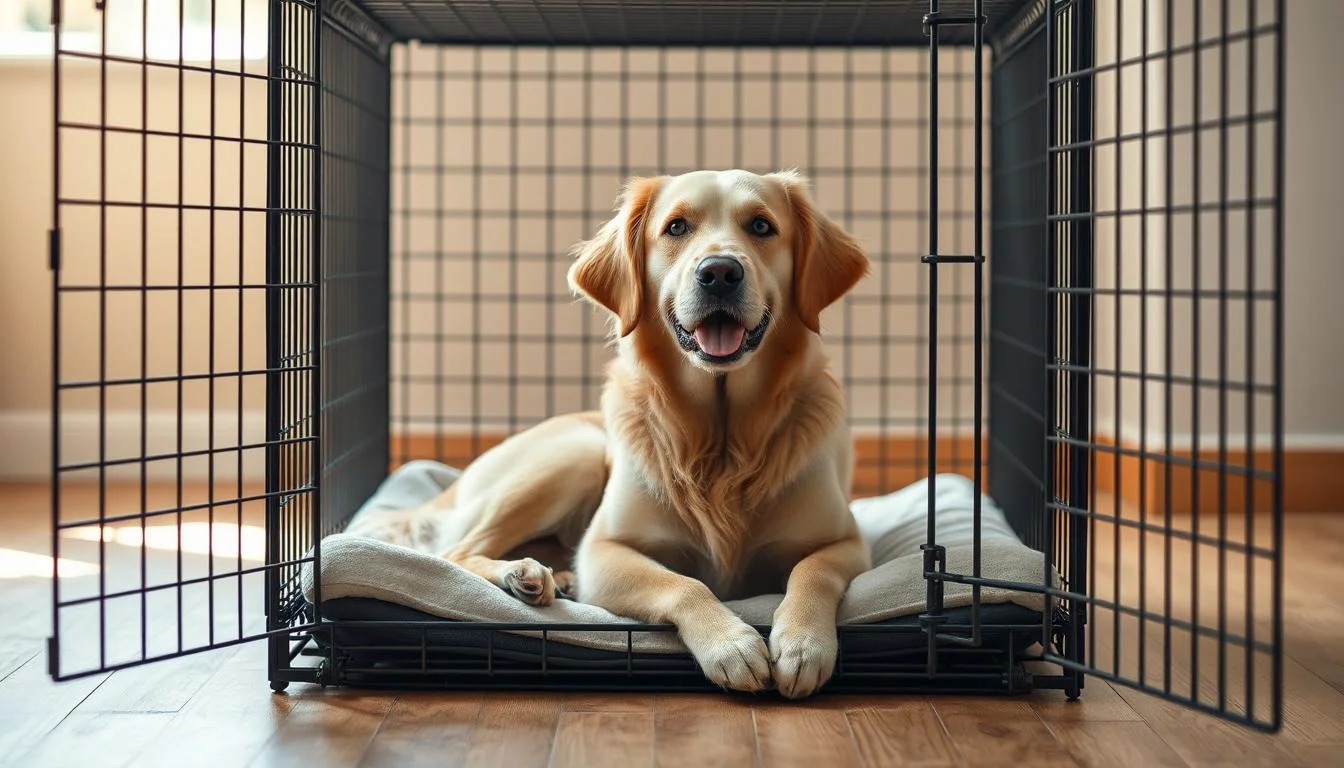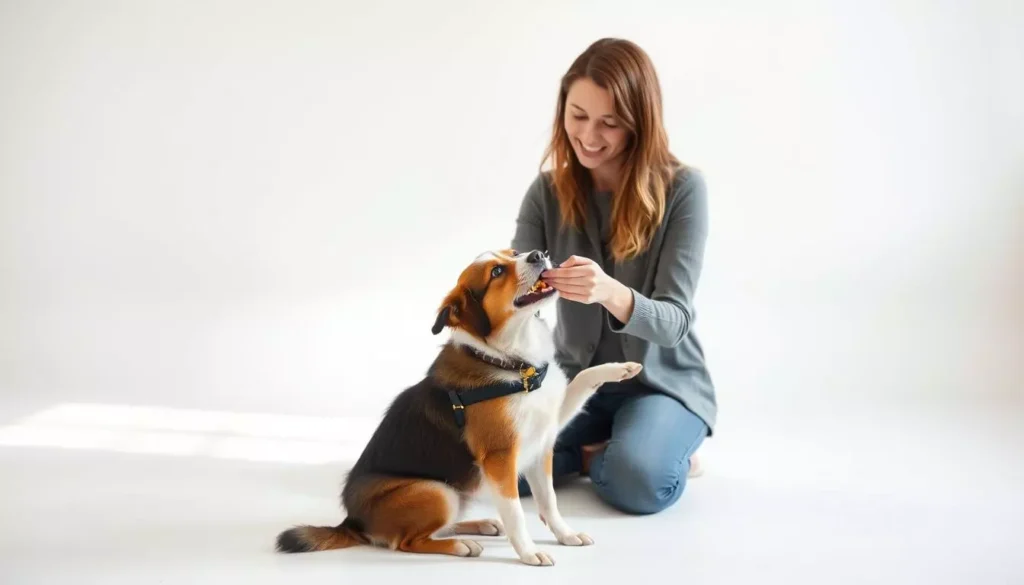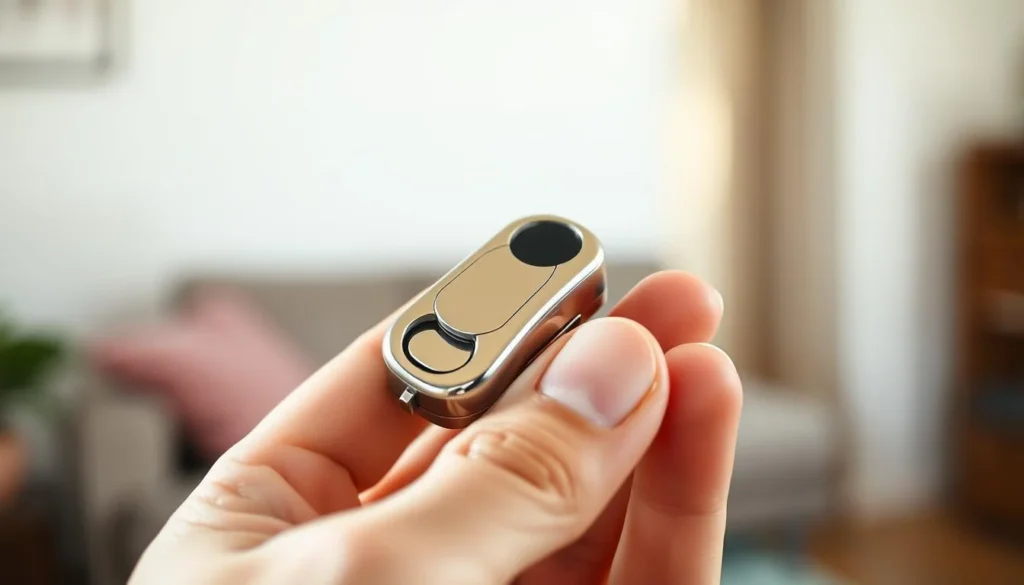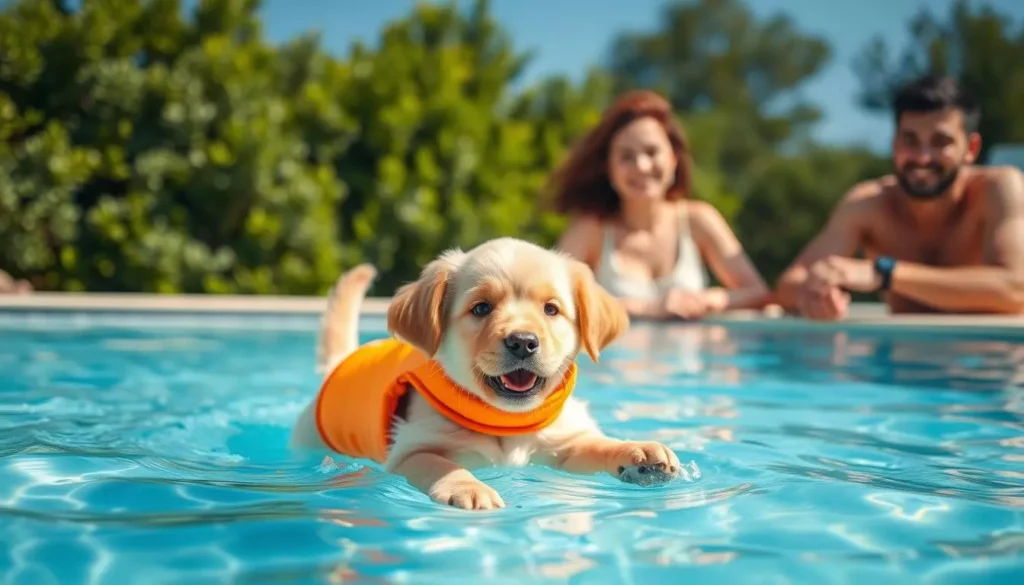I remember the first night with my Labrador mix. She curled up in a laundry basket, trembling. I wanted her to feel safe, not trapped. I worried crate training would be punishment.
But I learned that a crate is a sanctuary for a dog. It's a quiet, familiar place they choose to rest. This change improved our nights, outings, and vet visits.
In this guide, I'll share crate training essentials. I'll show you how to crate train your dog gently and effectively. I used tips from trainers and experts.
My goal is to help you build trust and routine. This way, your dog will see the crate as a safe den, not a timeout.
Remember, patience and consistency are key. Progress will come in small steps. Start with short sessions, reward calm behavior, and give plenty of outdoor breaks.
When done right, crate training can calm anxiety. It supports house-training and makes travel and vet visits less stressful for both of you.
Key Takeaways
- A crate can be a dog’s safe, den-like space when introduced calmly and positively.
- Start short: begin with 10-minute sessions and reward calm behavior.
- Choose the right crate size and use dividers for growing puppies.
- Never use the crate as punishment; remove collars and tags for safety.
- Plan for consistent practice—crate training can take weeks to months.
Why Crate Training Works and the Benefits for Dogs
I've seen crates calm nervous puppies and give adult dogs a quiet place to rest. Crate training for dogs is about giving them a safe, private spot. It's not a place of punishment.
I start with short, calm sessions to teach dogs that the crate means rest. Begin with ten minutes, then gradually increase the time. This builds trust and supports house-training.
When deciding whether to crate train a dog, I consider the pros and cons. A crate can make travel, vet visits, and grooming easier. It also keeps a dog safe in a car.
I advise against using a crate as punishment. Instead, make it a welcoming space. For puppies, limit crate time to a few hours to avoid stress.
Some dogs may not do well in crates. I suggest a tether or a small, dog-proofed room as alternatives. My guide focuses on positive reinforcement and scheduled nap times.
I've made a table to help owners decide if crate training is right for them. It compares the benefits and humane limits of crate training.
| Goal | Crate Results | Humane Limit |
|---|---|---|
| House-training | Speeds learning by preventing indoor accidents when supervised | Puppies under 6 months: 3–4 hours max; adults: breaks every 4–6 hours |
| Preventing destruction | Reduces chewing and roaming when owner is away | Use toys and short sessions; avoid full-day confinement |
| Travel and vet visits | Familiar crate eases car rides and clinic stays | Keep crate padded and never use for long-term isolation |
| Emotional comfort | Provides den-like retreat that lowers anxiety when trained gently | Introduce slowly with rewards; never force entry |
Choosing the Right Crate: Types, Size, and Placement
I want to help you find a crate that meets your dog's needs and fits your home. A good crate is durable, comfortable, and flexible. This makes crate training easier.
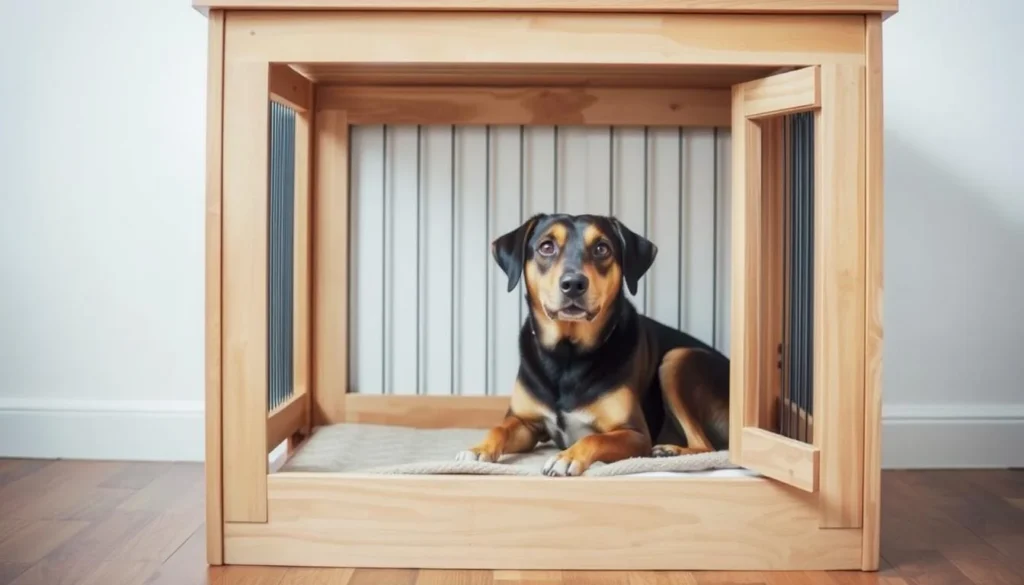
Types to consider:
- Wire crates: sturdy, ventilated, and foldable for storage. They're great for dogs that like to see what's going on.
- Plastic/flight kennels: cozy and darker inside, perfect for travel and vet visits.
- Fabric crates: lightweight and easy to carry, but not for long, unsupervised stays.
- Heavy-duty metal or reinforced plastic: best for dogs that try to escape or chew a lot.
How to size a crate for adult and growing dogs:
Measure your dog from nose to tail and add a few inches. This lets them stand and turn. Choose a crate for the adult size, not the puppy size.
Using dividers and adjustable crates for puppies:
Dividers help you adjust the space as your puppy grows. I suggest wire crates with built-in dividers or plastic crates with panels. This keeps the space right for your puppy and helps with house-training.
Best home locations and overnight placement:
Put the crate where your family spends time to make your dog feel part of the family. For nights, start with the crate beside your bed to ease anxiety. Move it away from walkways to avoid tripping.
Crate training essentials include a comfy mat, a chew-safe toy, and a routine. For nighttime crate training, have a consistent bedtime and a bathroom break before bed. This helps your dog adjust.
If you're crate training at night, start with short, calm sessions. Gradually increase the time. This makes the routine predictable and less stressful for both of you.
Establishing the Right Mindset for Crate Training
I want your crate to feel like a safe den, not a jail. Start with calm, short sessions and reward relaxed behavior. This way, the crate becomes linked to comfort. I never use the crate as punishment.
Using it after play or scolding creates negative associations and slows progress.
I rely on force-free crate training methods that focus on baby steps. I lure my dog in with tasty treats, KONGs, or safe chews and praise quiet settling. Teaching a clear entry cue and an “all done” exit cue builds structure and self-control.
These crate training tips help dogs learn faster without fear.
I set realistic expectations and remind myself that change takes weeks or months. Anna Flayton and many trainers stress patience and steady routines. If I rush to crate train dog fast, I risk setbacks and stress for my pet.
Small wins add up when I stick to a consistent plan.
When whining starts, I judge the cause. If it’s a test, I ignore brief protests so I don’t reward attention-seeking. If the dog needs to eliminate, I use their bathroom cue and take them out promptly.
Clear rules make the process predictable for the dog and everyone in the home.
Family etiquette matters. I remove collars and ID tags before crating to avoid entanglement. I ask everyone to respect the crate as the dog’s safe space—no tapping, poking, or sudden interruptions.
Consistent household rules speed learning and lower stress.
For dogs with more fragile nerves, I adapt methods to crate train dog with separation anxiety. I combine short, calm departures with rewarding returns. I avoid abrupt long absences and consider daycare or a pet sitter if I must be gone for hours.
These gentle steps and focused crate training tips make progress possible even for anxious dogs.
Step-by-Step Introduction to the Crate
I guide you through the first steps to teach a dog to accept a crate. The goal is to create calm curiosity, not force. Start with short, positive moments to build trust and make the crate a welcoming place.
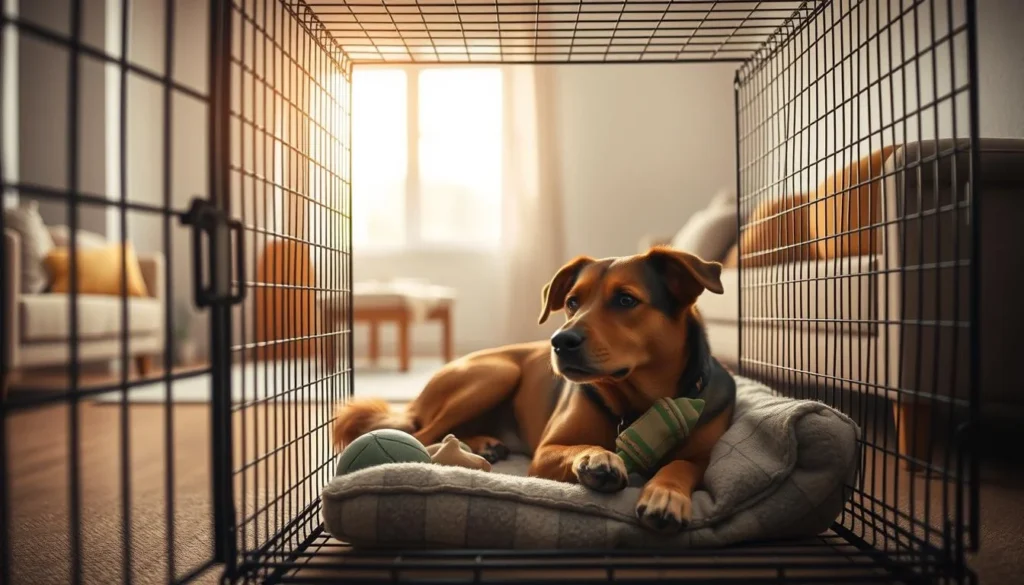
Let your dog explore freely
I place the open crate in a busy area and leave the door open. This lets the dog explore at their own pace. I toss treats inside to encourage them to enter.
Keep the first sessions short, about ten minutes. Afterward, reward the dog outside with praise or a short walk. These small rewards teach the crate is safe and worth coming back to.
Use treats and toys to create positive associations
I use treats and favorite toys to lure the dog inside. A frozen KONG or a long-lasting chew helps them stay longer. I reward calm behavior after they enter.
If whining starts, I slow down. Rushing can make things worse. I shorten the time the door is closed and reward the dog for calm behavior.
Feed meals in the crate to build comfort
I move meals closer to the crate, then inside it. Once they eat calmly inside, I close the door for longer periods. This is a key tip for crate training.
I teach a clear cue for entering and exiting the crate. I use clicks and treats to shape calm behavior. Over time, I remove treats so the cue is all that's needed.
- Begin with free exploration and short calm sessions.
- Use treats, toys, and KONGs to lengthen comfort.
- Feed meals inside to create a strong positive link.
These steps make a simple guide for the first week. If you're crate training a dog for the first night, make the area familiar. Keep the crate near you for security. With patience, the crate becomes a safe space your dog chooses.
Building Time in the Crate: Short Sessions to Overnight
I start with very short closed-door sessions and increase them step by step. I place a frozen KONG or a favorite chew inside so the dog has something engaging while the door is closed. This makes the crate a safe, positive place before I try longer stretches.
I use a simple progression: seconds, then minutes, then longer periods. If the dog whines, I wait for calm behavior before opening the door. This teaches patience and reduces attention-seeking.
Gradually extending closed-door periods
I time each session and only increase duration when the dog stays calm. I practice short closed-door sessions several times a day, then add five to ten minutes every few sessions. A camera helps me watch for stress and reward quiet behavior when I return.
Crate train dog at night: bedside placement and night routine
I keep the crate in my bedroom or a nearby hallway for the first nights. Puppies need bathroom breaks and comfort; having the crate nearby helps me hear whining and respond promptly. I add a warm toy or a safe hot water bottle for soothing warmth.
Crate train dog during day: practicing with short absences
I practice leaving the house for very brief errands once the dog tolerates about 30 minutes with me mostly out of sight. I vary the time I crate during my getting-ready routine so the dog cannot predict long absences. Short, frequent departures build confidence faster than a sudden, long first absence.
Suggested crate training schedule for puppies and adults
I follow age-based limits and nap scheduling to avoid overtired pups. For puppies I use the one-hour-per-month guideline: a three-month-old puppy gets about three hours max between breaks. Adults who are house-trained can often handle up to eight hours if given exercise and a safe chew before crating.
| Age / Type | Suggested Max Time Crated | Key Tips |
|---|---|---|
| 8–12 weeks (puppy) | 2–4 hours | Short, frequent naps; overnight near bedroom; frequent bathroom breaks |
| 3–6 months (puppy) | 3–6 hours | Build closed-door tolerance; practice brief absences; use frozen KONGs |
| 6–12 months (adolescent) | 4–6 hours | Increase independence; schedule exercise before crating; monitor whining |
| Adult (house-trained) | Up to 8 hours | Provide exercise and bathroom break before and after; safe chews during absence |
| Overnight transition | Progress to full night | Start bedside, then move crate gradually to preferred overnight spot |
Crate Training Methods and Practical Tips
I share simple crate training methods that I use with my dogs. These methods help build calm, confident behavior. Start with short, rewarding sessions and add variety to make the crate a positive place.
I teach an entry cue such as “crate” and reward calm behavior. I give treats as the dog goes in and again while the door is closed. This helps crate train dog fast without rushing the learning process.
I use interactive toys like KONGs filled with peanut butter and frozen treats. Puzzle toys and long-lasting chews make the crate a fun retreat. These items are key to many effective crate training tips.
I play simple crate games: toss a ball into the crate or hide treats. This makes the crate a fun place, not a punishment. I mix rewards with gentle shaping using a clicker or marker word.
I practice increasing closed-door time by sitting nearby first, then stepping out of sight. If whining is clearly a test, I ignore it while watching for signs the dog needs a bathroom break. I lower my excitement at arrivals to prevent separation anxiety.
I add an “all done” cue to signal calm exits from the crate. This cue teaches self-control and prevents door-dashing. Using this cue alongside treats rewards composed behavior before release.
If whining persists, I reduce closed-door length and add distractions or comfort items. I never open the door as a direct reward for attention-seeking noise. Small adjustments help most dogs settle, and these crate training tips work well on the first night and during training ramps.
When preparing for overnight stays, I sometimes elevate the crate near my bed. Placing a frozen KONG inside, adding a soft blanket, and keeping a steady routine helps crate train dog first night with less fuss.
I aim for consistency and short, frequent practice. This approach lets me crate train dog fast while keeping the experience positive. Small, steady wins build trust and long-term success.
Handling Common Problems and Special Cases
I guide owners through common crate issues with a calm, practical voice. Some dogs may whine or bark, while others show true distress. I help you understand the difference and choose humane steps to protect your dog's safety and emotional well-being.
I share clear signs to help you respond. If your dog whines to test you, ignore them briefly while watching with a camera. When calm, reward them to link quiet with good outcomes. If they pace, drool, or try to escape, stop the session and take a break.
Training anxious dogs requires different crate training tips. Crating alone won't solve separation anxiety. Use counterconditioning and desensitization with a certified animal behaviorist. Never reward whining by opening the door; it reinforces the behavior.
I suggest safe alternatives if the crate worsens things. If your dog tries to escape constantly, gets injured, or shows constant stress, it's time to try something else. Consider a secure room, exercise pen, or supervised tethering indoors. Dog daycare or one-on-one sessions with a trainer can also help.
I provide practical ways to rebuild trust with your dog. Shorten closed-door time, add comfy bedding, and place the crate near you at night. Use treats, meals, and positive exits to reintroduce the crate. If progress is slow, go back to earlier steps and be patient—training can take months.
I also share urgent safety steps. If your dog injures itself trying to escape, remove the crate until you have a plan. Consult your vet about stress-induced health issues and seek a certified behavior consultant for a tailored plan. My focus is on humane care and steady, evidence-based progress.
Potty Training, Age Limits, and Time-in-Crate Guidelines
I explain how long a dog can stay in a crate, potty needs, and a crate training schedule for home use. Dogs need regular exercise, meals, and bathroom breaks outside the crate. Leaving a dog for too long can lead to accidents and stress.
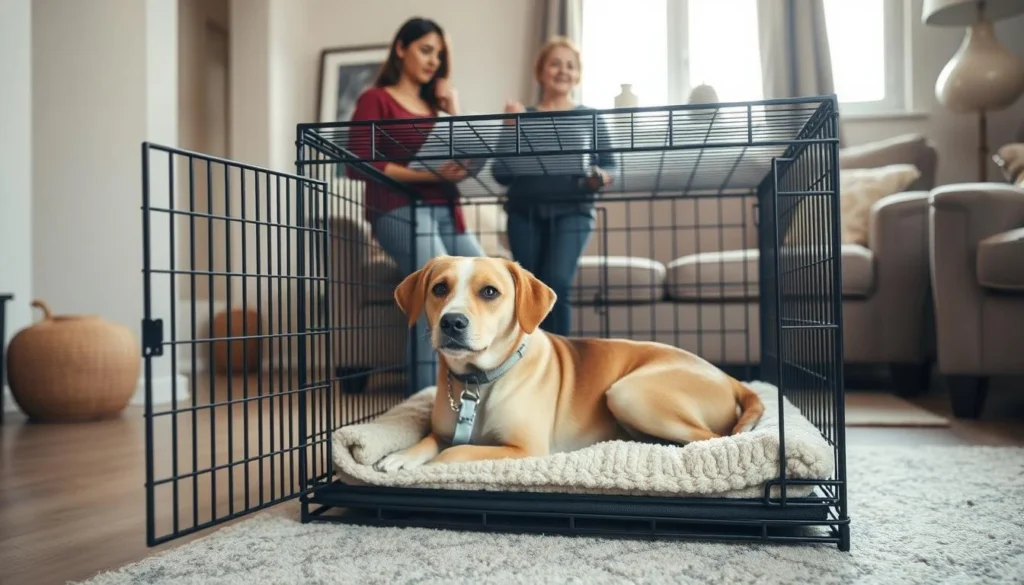
How long to leave a puppy or adult dog in a crate
Puppies under six months can't hold their bladder for more than three to four hours. I stick to this limit to prevent accidents and teach bladder control. An adult dog that's fully house-trained can handle up to eight hours if it gets good exercise before and after, plus safe chews or enrichment inside the crate.
One-hour-per-month guideline and practical adjustments
A good rule of thumb is one hour per month of age, up to eight hours for adults. For example, a three-month-old would get about three hours. I adjust this for health, breed, and temperament. Small breeds and toy dogs often need more frequent breaks.
Nighttime needs, bathroom breaks, and gradual independence
At night, puppies should sleep in the crate to learn bladder control. I suggest placing the crate next to your bed so you can hear needs and respond quickly. As the puppy sleeps through the night and stays calm for 30 minutes when you step away, you can extend absences and begin to crate train dog overnight with confidence.
I provide a simple crate training schedule that balances comfort and limits. Start with short, supervised sessions and build up. If you want to crate train dog at night, keep routines consistent: a trip outside before bed, a calm wind-down, and the crate nearby. Over weeks and months, move the crate to its permanent spot as the dog gains independence.
- Young puppy: 30–60 minute supervised sessions, max 3–4 hours awake.
- Older puppy (3–6 months): One hour per month guideline, increase slowly.
- Adult dog: Up to 8 hours with proper exercise and enrichment.
Crate Training for Travel, Vet Visits, and Long-Term Use
I use crate training to make travel, vet visits, and boarding calm for my dog. A consistent routine and the right crate type cut stress. This guide explains how to prepare a dog for trips, make clinics less scary, and move toward more freedom over time.
I choose kennel-style plastic crates for flights and long car rides because they give privacy and meet airline rules. At home, I favor a sturdy wire crate that offers airflow and visibility. Pick crates that match size and safety needs for secure transport.
I feed meals in the crate on travel days so the crate becomes a safe place. Bringing the familiar crate mat and a favorite toy to the vet helps a dog relax in waiting rooms and on exam tables. These small steps show clear crate training benefits for dogs during stressful events.
I teach my dog a calm entry cue before any trip or appointment. Short sessions with praise and treats build trust. This practical how to crate train a dog routine focuses on positive reinforcement and gradual exposure.
I prepare a car-safe setup by anchoring the crate and placing it on a flat surface. For airline travel, I check current carrier rules and choose an approved crate. This crate training guide approach keeps safety and comfort first.
I use the crate mat as a cue for calm behavior at the vet and groomer. When the mat appears, my dog knows this is a quiet spot. Using the same mat at home and away reinforces the association quickly.
I let the dog graduate from crate to a confined, dog-proof area before full house access. A kitchen or exercise pen gives supervised freedom while protecting furniture and potty habits. This step protects training gains and reduces setbacks.
Over time, the dog will enter the crate willingly for rides, vet visits, and overnight stays. I find a steady plan and familiar items make transitions smoother. This crate training guide and the crate training benefits for dogs pay off in safer, calmer travel and visits.
Quick-Start Strategies: How to Crate Train Dog Fast (Without Cutting Corners)
I want you to see quick, steady progress without stressing your dog. My method focuses on calm, short steps and consistent rewards. This makes learning fast and lasting.
Core fast-track principles:
I use brief, repeatable sessions for the dog to build success. Meals and frozen KONGs in the crate help them stay longer. Rewarding quiet behavior and keeping entries calm is key. A camera helps me see if the dog is relaxed or anxious, so I can reward the right moments.
Combining play, exercise, and calm entry:
Exercise before crating makes naps more likely. I take the dog for a short walk or play fifteen minutes, then invite them into the crate with a cue. A consistent crate training schedule mixes short absences and planned nap times to prevent overtired whining.
Avoiding shortcuts that set you back:
Fast does not mean forced. I never push a frightened dog into a crate or open the door whenever they whine. I avoid crating for excessive hours and never reward testing with immediate release. If progress stalls, I step back to smaller steps and stick to proven crate training methods.
Here are a few practical crate training tips I follow:
- Use a clear cue for entry and click-and-treat to shape the behavior.
- Start with one to five minute closed-door intervals and build up slowly.
- Make departures low-key and arrivals neutral to reduce anxiety.
- Schedule daytime naps and crate sessions to match the crate training schedule.
With patience and a simple routine, you can crate train dog fast while keeping the process humane and lasting. The right balance of exercise, short steps, and steady rewards speeds learning without risking setbacks.
Conclusion
I've shared a guide on crate training that covers the basics: the right crate, positive reinforcement, and small steps. Crate training helps with house-training, reduces anxiety, and makes vet visits calmer. Remember, patience is key, even when progress is slow.
It's important to remember that crates are tools, not solutions. They should be used humanely, with time limits and no punishment. If your dog shows extreme anxiety, it's best to get professional help.
When crate training is done correctly, it offers many benefits. Dogs get a safe space, easier travel, and quiet time. Spend a bit of time and use treats to help your dog feel more comfortable and trusting.

